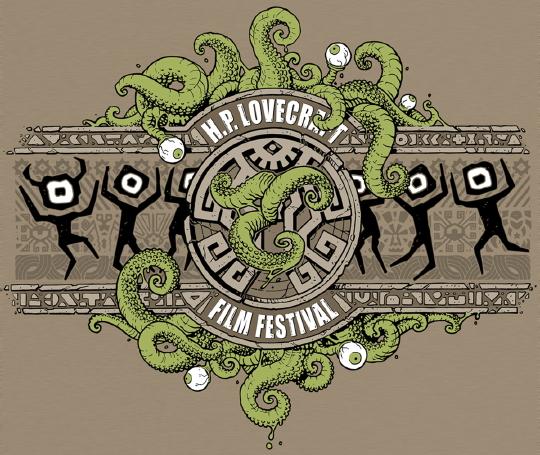
[apologies for the lateness getting this up. Some personal strife has prevented me from writing, until this moment. We now resume our regular transmission of blood ‘n bones]
As I sat on a park bench outside of the Art Deco exterior of the Hollywood Theater, on the nicest day of the year so far in Portland, not only did it seem like a victory and a vindication of the weird words and worlds of Howard Phillips Lovecraft, but for the whole of SF fandom.
The HPL Film Festival was started in 1995 by Andrew Migliore, with the hope that Lovecraft would be more widely recognized as a master of gothic horror and that his works might be more faithfully adapted to film and television. This is a great public service, as most people who admire the work of Lovecraft would probably admit, traditionally Lovecraft’s works, when translated to the big screen, are bloody awful.
The Film Festival has taken great strides towards giving Lovecraft’s work legitimacy, which is prompting a resurgence in inspired Lovecraftian film, as well as unearthing rare and forgotten gems.
This year’s event was the most sprawling and inspired to date, 3 days jam packed with panels, workshops, open gaming, literary reading and discussions, and a mouthwatering array of short and feature length films, with many actors and directors present for Q&A’s afterwards. Notable attendees of this year’s festival were notorious Lovecraftian scholar S. T. Joshi, guest of honor Kenneth Hite, Call Of Cthulhu creator Sandy Petersen, Lovecraftian anthologist Robert M. Price, and a very special appearance by Doug Bradley, Hellraiser‘s Pinhead!
Due to poverty, I was only able to attend one day of the festival (many thanks to my girlfriend for funding my infernal research), so I opted for the last day, when most of the movies I was interested in were playing. From 1 in the afternoon to nearly midnight, I was submerged in a nocturnal half-life of primordial worlds; tentacled, fathomless beings and many of the greatest minds SF has produced, of the last 100 years.
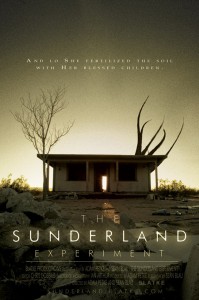 I arrived just in time to find the last seat for The Sunderland Experiment, which was probably my favorite of the 4 movies I saw (although I loved them all).
I arrived just in time to find the last seat for The Sunderland Experiment, which was probably my favorite of the 4 movies I saw (although I loved them all).
The Sunderland Experiment tells the story of David and his hometown of Sunderland, a desolate desert town barricaded behind an electric fence. Ten years ago, an extraterrestrial being called The Angel descended on Sunderland and commenced to transform the adults into shuffling, shambolic beings, in a process known as “Blessing”. Those that refuse to become blessed become The Fallen, and are exiled into the wasteland.
At the beginning of the movie, David is the ultimate immature adolescent, a Dennis-The-Menace sort at the end of the world, until he accidentally catches a bullet between the eyes and is resurrected by The Angel, creepily voiced by Dennice Cisneros, who is like a cross between a Wooly Mammoth and a Japanese Fish Market. David has an experience of the Void, and returns with a vigor to become Blessed, as “anything is better than…. nothing.”
The Sunderland Experiment works so well, as it is essentially a coming of age story, in the face of Cosmic Horror and post-apocalyptic wasteland. The teenagers are amusingly emotionally stunted, essentially children despite their age, seeing as how they’ve been living behind an electric fence for 10 years. A lot of the story revolves arounds kids catching a buzz, ditching Sunday School, discovering sex, all the joys of adolescence, but in the most unsettling way imaginable.
This unease is further emphasized by liberal platterfuls of Body Horror, as the chosen get closer to becoming blessed, to begin their new life in The Garden. The adults in the town are putrescent beings that speak in gargling voices. There is a scene when David comes home to his beyond-squalid family home, to find his mother just standing and retching into a sink. This visceral quality, when juxtaposed with the coming-of-age innocence, is particularly unnerving, and I noticed a number of people in the theater getting uncomfortable at the particularly meaty and juicy physicality of this film.
The other thing that makes The Sunderland Experiment such a success is a number of likable and relatable characters. David starts off as a little brat, but quickly becomes deep and still as a Zen Pond, after his demise. The other star of the movie is the innocent and ethereal Cassie, played by Katie Reed, the daughter of the school teacher, who kept her locked away from the world. She is an overgrown girl that is quickly becoming a woman. Her reactions to many of the unspeakable events, which include putting on plays with her teddy bears, are endearing and frightfully realistic, which gives a much-needed human element to the Cosmic Horror, which is something that is often lacking in Lovecraftian Works.
My other favorite was a willfully fallen boy named Krab, who is eking out a living in the wasteland, and is, quite frankly, hilarious.
I’m being purposefully vague, as far as plot, as a lot of this movie is the mystery and suspense, as David and his friends seek to understand The Angel and if, in fact, anything is better than Nothing.
This is one of the better horror films I’ve seen in a minute, a daring and auspicious debut from Directors Sean Blau and Adam Petke. It is visually delicious, with great special FX and beautiful footage of ruinous and desolate places.
The Sunderland Experiment is like some extreme Mormon cult, taken to its furthest and most sinister conclusions. Anybody who loves post-apocalyptic cinema, Body Horror, doppelgangers, zombies, dark humor, abandoned buildings, and of course, tentacled monsters, stay tuned for this to come out on DVD or make it’s way to your town.
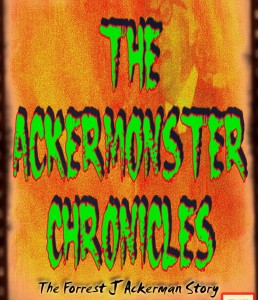 The Ackermonster Chronicles:
The Ackermonster Chronicles:
Next up was a nearly empty showing of The Ackermonster Chronicles, which I thought would be of special interest and pertinence to readers of Amazing Stories.
Forrest J Ackerman (aka “Forry”), was the ultimate SuperFan. He ran a museum of sci-fi, horror and fantasy movie memorabilia out of his Hollywood home for over 6 decades. He coined the term “sci-fi”. He was Ray Bradbury‘s first literary agent, and introduced him to Ray Harryhausen, who would remain a lifelong friend. He hung out with Ed Wood and Bela Lugosi. He published over 50 SF stories in his life, and had bit parts in over 210 films, including a brief cameo in Michael Jackson’s Thriller video (that’s Forry, sitting behind MJ and his girl in the movie theater). He was best known as the original editor and principle write of Famous Monsters Of Filmland, and the creator of the comic book character Vampirella.
His was a life dedicated to the fantastic, the horrific and the imaginative.
The Ackermonster Chronicles occasionally has the feel of a cheap, made-for-local-TV documentary, which was a bit jarring at first, but ultimately lent to the b-movie charm of this feature-length documentary. And who needs flash graphics when you’ve got as much great content as writer and director Jason Brock has gathered together, with tons of archival footage and interviews with luminaries like Greg Bear, Joe Dante, John Landis, Richard Matheson, S. T. Joshi and Ray Bradbury telling great stories of their reminiscences of Forry, and how his home and his magazines would inspire and direct them in their careers.
In short, The Ackermonster Chronicles is like watching a time elapsed history of 20th Century Sci-Fi, from many of its originators and innovators. As such, it gives interesting, behind-the-scenes looks at many of sci-fi’s triumphs (Ackerman talked of his feeling of vindication when we landed on the moon), as well as much of the petty politics and in-fighting our scene is known for (we are an opinionated lot), like his longstanding feud with Harlan Ellison (who HASN’T had a feud with Harlan?).
And its not all politics and rubber masks, as the documentary takes amusing detours and strolls through nudism, Ackerman becoming an official lesbian and ghost-writing for the first ever lesbian publication, Vice Versa.
In a lot of ways Ackerman’s life and career seems like a microcosm of the future we are now living in: a world of fan fiction and penpals all over the world. A world of collaboration and unlikely connections and opportunities, as many who grew up reading and loving the early SF pulps would end up writing for them and running their own. A world of trolling, and feuds, competition and camaraderie – sexy, imaginative, and immature.
And that’s why seeing this movie, and writing on the life and times of Forrest J Ackerman seems so oddly poignant and perfect, as Ackerman’s lifelong love of SF began with a chance encounter of Amazing Stories magazine in 1926. AS, and the other pulps, were like the earliest incarnation of the blog/message board culture we are living in, now, and we’ve come full circle.
Which is why it’s important to consider where we’ve come from. To have a better idea of where we’re going.
The Ackermonster Chronicles is funny, inspiring, moving, imaginative. It is a treasure trove of archival delights, that is essential for the collection of every true SuperFan.
After an hour-and-a-half break, squinting at the sunlight, I returned from lunch to the film I was most anticipating, the indie phenomenon Lord Of Tears, the origin of Owl Man, as seen on the internet.
Lord of Tears tells the story of James Findlay, a school teacher plagued by recurring nightmares of a mysterious and unsettling entity. Suspecting that his visions are linked to a dark incident in his past, James returns to his childhood home, a notorious mansion in the Scottish Highlands, where he uncovers the disturbing truth behind his dreams, and must fight to survive the brutal consequences of his curiosity.
While investigating his family home he meets the mysterious Evie, who helps takes his mind off the gloom and oppressive nature of the house, and the dreams that have been haunting James.
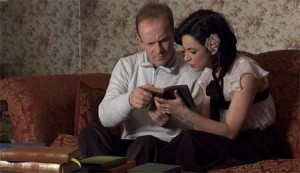
James dreams of an man-sized owl with a booming voice and elongated arms, and repressed memories from his childhood begin to surface.
Turns out that his childhood home in the Highlands was once the site of a pagan sacrificial site dedicated to an Old Testament deity known as Moloch, the god of Human Sacrifice. There are rumors that Moloch could cure the sick, for a price.
Again, as with The Sunderland Experiment, I don’t want to give too much away as this is truly a slowly unfolding mystery, and to give it away would ruin it. So just a couple of quick thoughts, on what works and what doesn’t.
1. Evie – Evie borders on being the classic “Manic Pixie Dream Girl” whose only purpose is to surprise and delight the male protagonist, while having no life of her own. Evie IS quirky, but is weird and ethereal enough to make her an interesting character. Her dance sequences are sublimely graceful and beautiful, even if there are about 20 too many scenes of her approaching the camera, bordering on what MST3K used to call “rock climbing”.
2. The Sound – There are several moments in this film when the sound FX and music overwhelm the dialogue, breaking you out of your reverie and snapping the otherwise very immersive spell LOT casts on the viewer.
3. Moloch/”The Owl Man” – The Owl Man is a very cool villain, with lots of existential philosophizing, worthy of pinhead. For what it’s worth, and I mention it only in the spirit of Lovecraftian scholarship, in the Bible, Moloch was traditionally associated with a golden calf, not an owl, and the owl-headed demon pictured in the film, while associated with sacrifice and murder, is actually named Andras, not Moloch. When dealing with infernal spirits, it’s very important to get the names right.
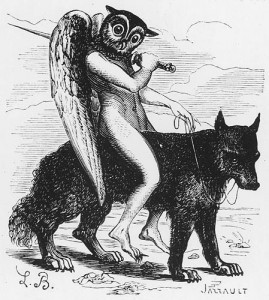
Again, like The Sunderland Experiment, Lord Of Tears is the directorial debut from Scottish director Lawrie Brewster. Its a model of a successful and intriguing viral marketing campaign, an example of how to do an indie film right. There are a few missteps along the way, it is not a perfect debut, but it is a stunning one. It’s gorgeously shot, with a lot of crisp b&w. The characters seem real and relatable, with some real on-screen chemistry, particularly between James and Evie.
What I liked most about this film, and its inclusion in this festival, was a hearkening back to the gothic novel, with a spooky old house, full of secrets. There are a number of different strains and strands that run through the works of Lovecraft, and I feel that this one is often overlooked, in the face of his Mythos. Gothic novels (and film) are particularly unsettling, as they hit closer to home. They give a human edge to the unknowable, and make it more disturbing and fascinating. They give a face to the formless.
Lord Of Tears is an impressive debut, and a damn good indie horror flick. Its a spit in the eye to anyone who says “they don’t make movies like they used to”. Also, bonus skulls and bones for daring to release a slowly-unfolding, atmospheric chiller, in this day of immediate gratification and cheap jump-scares.
A quick dip out, to attend my first Cthulhu Cult ritual and then..
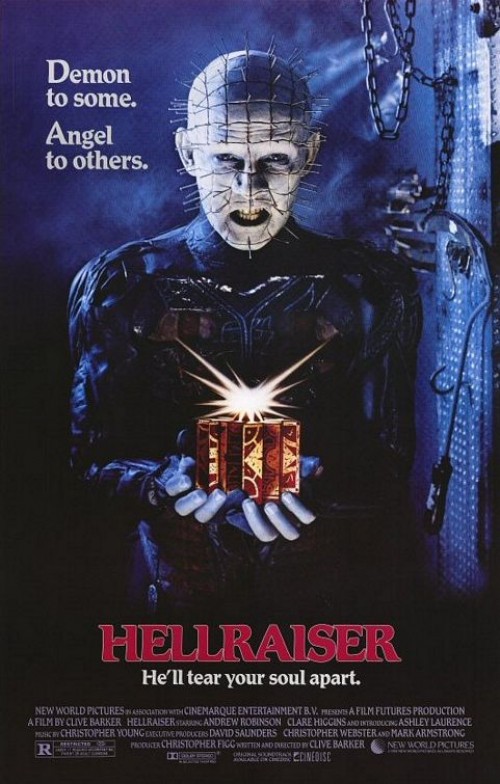
And last but not least, Hellraiser on a 60 foot screen, with Pinhead in attendance!
I didn’t even realize this was playing, until the very last second. I’d already seen nearly 10 hours of film, but I just couldn’t pass up the opportunity to breathe in the same air as Doug Bradley.
Most of the readers of these pages are probably no stranger to the dark delights of the original Hellraiser, so I won’t go into it at great length, except to say I how effective this monster is on the big screen. I had never seen it in the theater, and was blown away how much more effective, chilling and visceral the experience is, 60 feet tall and amplified through enormous speakers. You can really FEEL the meaty menace of the Body Horror, as slime and ichor fall from the skinless Frank’s bones, or as razor sharp hooks pierce flesh. And the mewling baby cry as Frank is reborn!!! You have not seen this film, unless you’ve seen it in the theater.
To round out a fantastic day, and a wonderful weekend, was a brief show ‘n tell from Bradley, who proved to be an erudite, charming, humble yet confident man with tons of interesting insights into the making of Hellraiser. Some of the topics were discussed were the unusual proliferation of bald English men seemingly in New York; how plastic used to glue wounded veterans guts together in Vietnam were used to apply Pinhead’s make-up and whether or not there is a God.
And that’s where the critical analysis stops, because I was 5 feet away from Pinhead!
Thank you so much to the organizers of the HPLFF, for doing a bang-up job, and breathing fresh life into Lovecraft’s works.
Although it seems strange, attending this festival was one of the high points of my life. I felt so at ease and at home in the 1920s decor, surrounded by black-clad and tattooed strangers, watching horror movies on a sunny afternoon. Particularly inspiring was the Ackerman documentary, which really helped to ease some of my doubts as to being a fledgling writer. Ray Bradbury is an eternal light and inspiration.
It is incredible, how the worlds being dreamed up by teenagers in the backpages of cheap magazines and comic books, nearly 100 years ago, are walking around in the bright light of day. All of these fans have dreamt this world into being, and it is our job not too take it for granted.
Lovecraft’s works look at the formless, the shapeless, the unknowable and unnameable (despite being a staunch materialist). It’s like he was peering into the unconscious, into the underground, which is now rising, like R’lyeh.
The next HLPFF is in October of ’15, but there’s supposed to be some events between now and then, so stay posted!

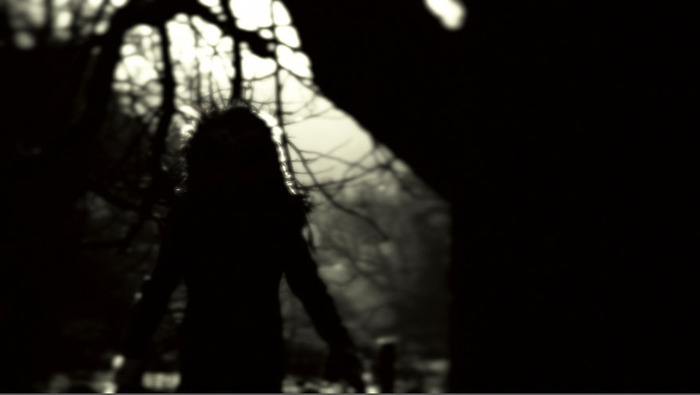




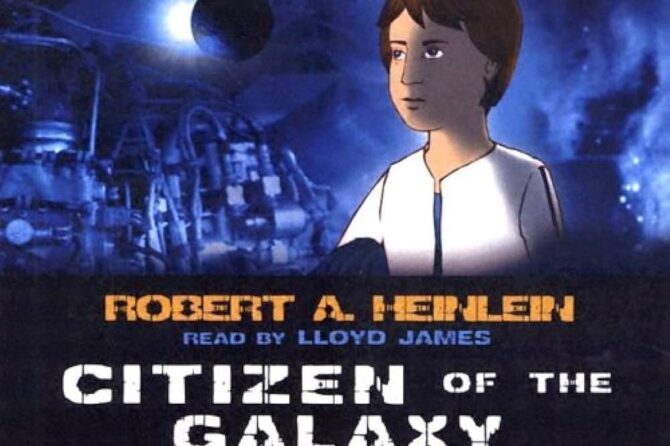





Recent Comments